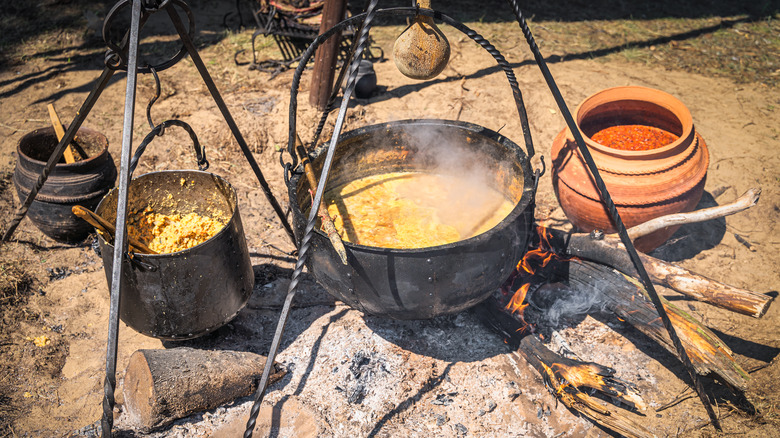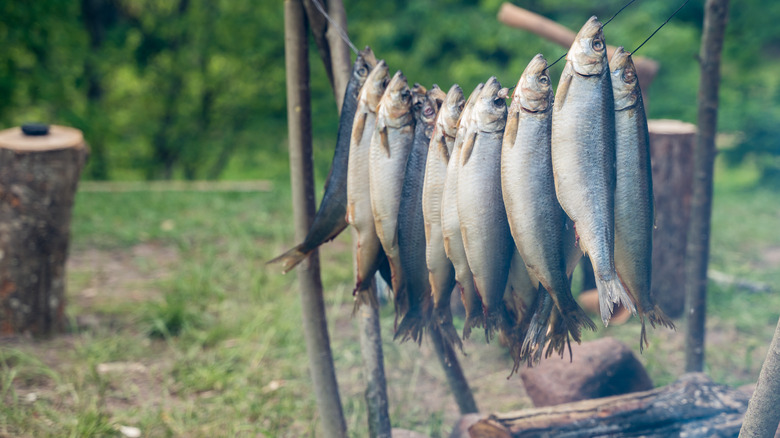What Vikings In 800 AD Really Ate
If you imagine the Vikings eating a bare, nutritionally poor diet, you'd be in for a surprise. Although there isn't much written documentation about their eating habits, experts believe the Viking diet was in fact much richer than the average English peasant's diet at the time (via History). Because of the harsh weather and how time-consuming it was to gather and then cook the ingredients, it was also often an all-day affair, especially when it came to meats and fish.
The Vikings preserved some of the meat by drying, smoking, salting, and, in winter, even burying it. Much of their food, however, was boiled in iron pots or cooked in clay jars. To avoid burning the food, it was necessary to continuously turn the jars or stir the pots, which meant the people in charge of cooking (usually women and older children) would have to spend hours by the fire attending to it (per Foteviken Viking Museum).
Since water was generally considered unsafe to drink, preparing drinks was another time-consuming job. According to the National Museum of Denmark, rich Vikings would sometimes have access to wines imported from France, but most drank a weak beer made from barley — and yes, that included everybody, even children. Stronger beer or mead (a fermented drink made with honey and spices) was reserved for special occasions and festivals.
The Viking diet included plenty of healthy foods
Vikings used the land around their villages to grow grains and vegetables. Parsnips, peas and cabbage were popular in their gardens and part of most meals throughout the day. To flavor their meals, the Vikings used mostly salt, but spices like wild horseradish were also available, according to History.
Grains were an essential part of the Viking diet. Barley was used to brew beer, which was their main drink, while rye, oats, and millet were used to make porridge to be eaten as breakfast food. Porridge was often sweetened with honey and had apples, elderberries, hawthorn berries, stinging nettle seeds, and nuts added to it, according to Foteviken Viking Museum. The traditional Viking bread was similar to today's Danish bread, a coarse sourdough made up mainly with rye (via the National Museum of Denmark). Because ovens weren't common in the Viking household, bread was often flat and either grilled over a fire or cooked in a pan.
While the Vikings didn't grow fruit trees, they definitely spent time gathering fruits. Wild berries and plums grew abundantly in the area and were collected regularly. According to the National Museum of Denmark, wild apples were especially valuable, as the Norse goddess Idun was the keeper of the magic apples of immortality, which she fed to the other gods to keep them young.
Animal products were an essential part of their diet
Viking families kept a number of animals to provide either meat or milk year-round. In addition to pigs, cattle, geese, and chickens, they also raised goats and sheep. The typical Viking diet was rich in fish, which was often dried and salted or preserved in brine for the winter months. Sausages were another way of preserving meat, especially important as they were made with the entrails and organs that would otherwise go to waste, as the National Museum of Denmark reports.
Animals also provided milk, and the Vikings made cheese and butter to get them through the long, harsh winter months. Nordic literature is full of references to cheese, making it obvious that it was not only an important part of the Viking diet but also considered essential for good health. During excavations, archaeologists have found hollow clay jars and oak chutes that were likely used to make cheese (per Foteviken Viking Museum).
And because the Vikings had access to cow, sheep, and goat milk, chances are they made different varieties of cheese to use both in cooking or to be eaten as snacks. Clabber cheese is the oldest form of cheese produced in the Nordic countries, and so it's likely the kind the Vikings favored. It is produced using naturally fermented milk to create something similar to cottage cheese.


